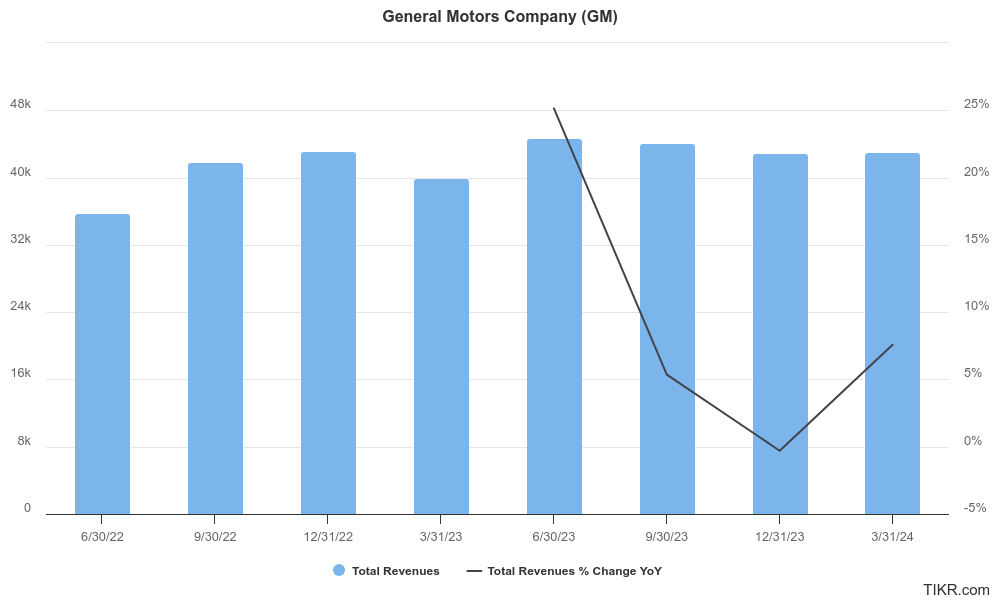
GM Stock Whipsaws Despite Q2 Earnings Beat: Key Takeaways
- Economy
- July 24, 2024
- No Comment
- 109
Please note that we are not authorised to provide any investment advice. The content on this page is for information purposes only.
General Motors (NYSE: GM) stock has whipsawed in today’s price action despite the company easily beating Q2 earnings estimates. While the stock was up sharply in pre markets it pared gains and opened in the red. Here are the key takeaways from the Detroit automaker’s Q2 earnings.
General Motors reported revenues of $47.97 billion in Q2 which was well ahead of the $45.46 billion that analysts were expecting. The company’s adjusted EPS was $3.06 which was higher than the $2.75 that analysts were expecting.
GM Raised Full-Year Guidance
The company also raised its annual guidance for the second consecutive quarter. It now expects to post adjusted pre-tax earnings between $13 billion and $15 billion in 2024 as compared to the previous guidance of $12.5 billion to $14.5 billion. It also raised the annual adjusted EPS guidance to $9.50-$10 – as compared to the previous guidance of $9-$10.
Wall Street analysts were expecting GM to post an adjusted EPS of $9.47 in the year. Overall, the company’s Q2 earnings and guidance were quite strong which is in contrast to its price action with GM stock down almost 7%.


GM Halts Cruise Autonomous Vehicle
One possible reason could be the indefinite delay in the production of the Origin autonomous vehicle from its self-driving unit Cruise. The company would instead use the next-generation Chevrolet Bolt for developing autonomous vehicles.
GM is also restructuring its China operations which have posted an equity loss for two consecutive quarters.
GM’s CFO Paul Jacobson said, “In China, we’ve been taking steps to reduce our inventories, align production to demand, and reduce our fixed costs, but it’s clear that the steps that we’ve taken, while significant, have not been enough.”
He added, “We’re working closely with our JV partner to restructure the business, to make it profitable and sustainable, while ensuring that it doesn’t require incremental capital.”
Notably, while China was once a lucrative market for foreign automakers, they are feeling the heat from domestic automakers. Chinese auto giant BYD for instance has become the biggest seller of new energy vehicles globally and looks set to surpass Tesla in terms of battery electric vehicle deliveries also.
EV Production
While GM has withdrawn the 2025 EV production target of 1 million units, it maintained the 2024 guidance of producing between 200,000-250,000 units. In the shareholder letter, GM CEO Mary Barra said, “As excited as we are about our EVs and our early success, we are committed to disciplined volume growth, which is the key to earning positive variable profits from our portfolio in the fourth quarter, which remains our goal.”
According to Jacobson, “EVs are going to be an earning headwind as we scale, until we reach variable profits positive during the fourth quarter, then they should start to become a tail wind for EBIT.”
Notably, rival Ford has also scaled back its once ambitious EV production targets as legacy automakers continue to lose money on every electric car that they sell.
GM Has Scaled Up Buybacks
General Motors, which announced a $10 billion accelerated share buyback plan last year authorized yet another $6 billion repurchase plan earlier this month. Ford said that it is committed to returning between 40%-50% of its free cash flows to shareholders, and along with the usual quarterly dividend it announced a special dividend of 18 cents per share during its Q4 earnings call earlier this year. The company announced a special dividend last year also after it sold its stake in EV startup Rivian. Ford has a dividend yield of almost 5% while GM’s yield is closer to 1%.
GM Has Preferred Share Buybacks While Ford has Paid Special Dividends
GM seems to prefer share buybacks while Ford has instead paid special dividends as both the companies have a problem of plenty when it comes to free cash flows.
While both Ford and GM are posting healthy profits and cash flows, they have scaled back on their EV capex as the demand hasn’t been as strong as previously expected. Also, they are very cautious while spending on their ICE portfolio which has meant they have plenty of free cash flows to play around with.
Markets meanwhile have been apprehensive about legacy automakers despite them posting stellar earnings and free cash flows amid concerns over their EV business. Even Tesla is not immune from the EV slowdown and its deliveries have fallen YoY for two consecutive quarters.
The Elon Musk-run company is set to release its Q2 earnings later today which would provide more insights into the EV industry.
#Stock #Whipsaws #Earnings #Beat #Key #Takeaways









